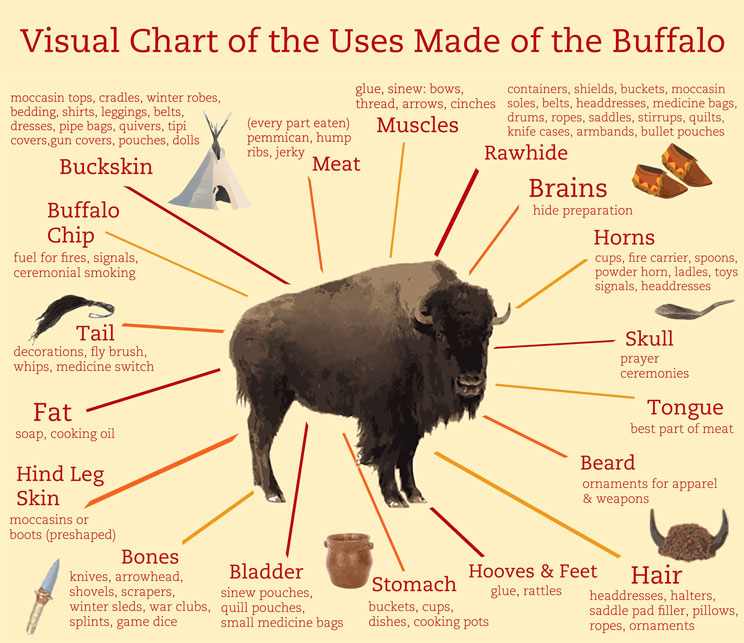The Buffalo

shared by St Joseph Indian's School
Introduction
Allow your imagination to travel, to travel back in time and out across The Great Plains (what is now known as the central United States of America), to a time when tribes of the Native American people called this land home. Specifically draw your imagination to what was arguably the most important thing to them, whatever tribe they came from, the buffalo. The killing of a buffalo was about more than just providing food for the Native Americans, it was an integral ingredient in almost every part of their life. Their relationship with the animal can be used as an almost perfect example of the embodiment of sustainability. Their ability to create multiple things (products) from one buffalo (source) is the complete inverse from today's civilisations (using multiple sources to create one product).
Activity Type
Group / Experiential
Duration
1-2 hours
Learning Outcomes
-
To understand how interconnected we are to the natural world
-
To realise how seemingly simple objects are related to a complex web of other things
Instructions
Required Materials and Tools:
-
One modern processed food (we will be using the example of a bag of crisps throughout the activity)
-
Flipchart and pen
-
Blank paper
-
Drawing utensils
Step-by-Step Instructions:
-
Tell the whole group some form of the following story; "We are a tribe of Native Americans lost on The Great Plains, our emergency supplies are running low and it has been several days since we ate properly, we are starting to get seriously hungry! We know that in order to survive long enough to have any chance of finding our way home, we must find and kill a buffalo as soon as possible. Just as all hope is almost lost, finally, in the distance, the sound of thunder! Clouds of dust! A herd of buffalo! We are all very good hunters, so before we know it, we are sitting around a campfire nice and full after a delicious meal of buffalo steak. Most of the buffalo, however, is yet to be used. We are thankful for the gift of the buffalo and know we must wisely use as much of it as we can. We will not waste any of it.”
-
Now ask the group to propose what else can be done with the rest of the buffalo, what else it can provide us with apart from food. As the group shouts out possibilities, write the answers on the flip chart. [Allow 5-10 minutes]
-
If the group is struggling or stuck, have a look at the picture here and suggest one or two options to the participants.
-
Now break the group up into smaller groups of 3-4 people. Each group should have:
-
Drawing utensils and paper.
-
A bag of crisps or other processed food.
-
Instruct the group to draw the bag of crisps in the centre of their page, then to take a few moments to explore and think about it. Think about its origins, how it was produced, its current use and form, its destiny and full life circle. Now we are ready to create this object’s story. The central question at this point is: What did it take to get this object to the place where it sits in front of you. Don’t leave anything out!
-
The groups should draw aspects of the object’s story and then connect them to the object in the middle by a line. [Leave 20 minutes for whole exercise]
-
A good starting point is to break the object down into its individual components (i.e. the bag, salt, other ingredients, crisps themselves, preservatives) and then to trace the origins of each individually.
-
From there you can start to branch out. e.g The crisps come from a potato. The potato is traced (connected by a line) to a farmer, a tractor, the sun, water, soil etc. The tractor itself then requires oil, water, fuel and metal to be produced etc etc.
-
Encourage the group to be as precise and thorough as possible, taking into account transportation of individual ingredients to centralised locations, the cooking process, packaging, pesticides, fertilisation etc. Everything must come from somewhere.
-
Bring the group back together and invite them to discuss, giving time for each group to look at the others drawings and comparing them to their own. Did anyone come up with anything the others missed? Do they all look the same? How is this different from the Native Americans relationship with their food, in general and the buffalo in particular?
Reflection
-
Can you give any examples of modern situations where multiple products are made from one source?
-
How would it change our world if we would use the ‘buffalo’ principle in most production?
Instructions for submission
Upload 1 photo of any group’s drawings and submit some key messages from the group discussions in Moodle (so that your peers can give you feedback). Instructions on how to upload a picture in Moodle or submit the key messages can be found here: Instructions on Submission&Uploading
Instructions for assessment
Provide feedback to at least one participant that has done this activity. Instructions on providing feedback can be found here: Instructions on Feedback
Author
Creative Commons - ySI4R Content Team (adaptation of Chris Uhls “Transforming the Ordinary”)